Users who permanently live in city apartments and private houses very often need additional points of connection to the Internet. In this case, the power outlet is the easiest way out of the situation, allowing you to arrange a connection node in each room. For various types of devices (devices), it can be equipped in the appropriate standard.
What explains the need for sockets
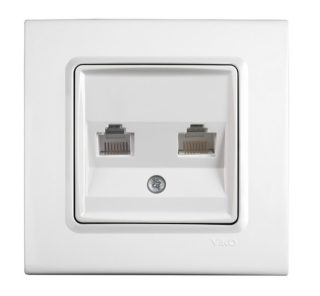
Any Internet user can say that if there is a router, the installation of LAN sockets throughout the apartment will be an unnecessary measure and duplication of functions. However, they will be opposed by many people who are worried about their health and are trying to reduce the level of high-frequency radiation generated by the device.
There is another compelling argument in favor of installing a LAN socket in remote rooms of a private residential building or city apartment. It lies in the fact that even the most expensive and advanced routers are not able to cover the significant spaces occupied by modern buildings. Within their boundaries, there will certainly be a point where the signal is weakened so much that there will be no reliable connection. In city apartments, such a place is a loggia remote from the router, where Internet access in the summer is also in demand.
In the presence of an extensive network of connected LAN outlets, all questions about the reliability of communication in large premises and country houses are automatically removed.
Classification of sockets
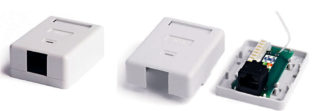
For the correct approach to choosing a suitable sample of network outlets, you will need to familiarize yourself with the existing classification of products designed for a unified RJ-45 connector. But first, you need to understand the features of this connection standard, formed using a typical 8-conductor wire called "twisted pair". The product received this name due to the characteristic interlacing of twisted wires placed in a shielded cable. By means of this standard the majority of high-speed communication channels are organized in networks of various categories.
Specialists in network information exchange have adopted the classification of twisted-pair sockets according to the following main features:
- the number of simultaneously used connectors;
- the speed of information transfer over the network;
- method of fixing on walls and other work surfaces of premises.
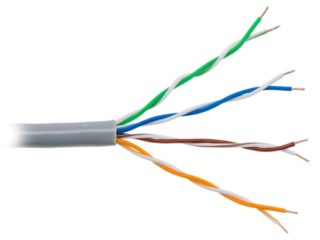
In accordance with the first feature, single, double, and also a special design terminal sockets with up to 8 connectors are distinguished. Another type is known related to combined products. They provide additional interfaces, such as audio, USB, HDMI and others, combined with RJ-45.
In terms of transmission speed, all known female connectors are divided into the following categories:
- Twisted pair 3E - data transfer rate up to 100 Mbps.
- The same product, but designated as 5E - up to 1000 Mbps.
- Sixth category - up to 10 Gbps.
According to the method of fastening, twisted pair sockets are subdivided into built-in / internal and overhead products. In the first version, the contact group is recessed into a niche in the wall, and for outdoor models it is located on the surface and is covered with a cover plate.
Applications
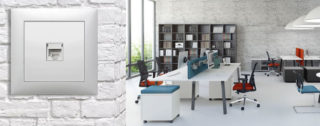
In addition to a purely home use case, power outlets are traditionally installed at a number of facilities:
- offices, classrooms and premises with server equipment located on them;
- Internet centers and library sites;
- IT shops and repair shops;
- secret laboratories and other restricted areas.
For modern offices, in addition to installing routers, it is necessary to have RJ-45 sockets, which allow you to connect the station's PC to the Internet and your own local networks.
In the premises of highly secret organizations, the installation of network sockets into the walls is the only way to safely access the Internet, since any radiating systems are prohibited in them. This precaution is due to the fact that the interception of classified information is possible through wireless transmission.
Features of cable laying
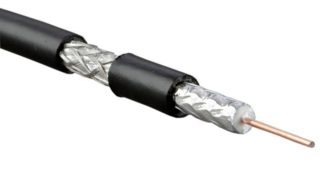
When laying a cable for Internet outlets, certain rules must be observed, the content of which depends on the type of loop, as well as on the location of the connections. The following types of cable products are traditionally used to organize Internet networks:
- twisted pair UTP;
- fiber optic lines;
- coaxial cable.
In addition to the type of connection, when designing it, it is important to pay attention to the type of core and the method of shielding the entire cable product.
The rules for laying any type of cable are governed by the requirements of the current standards ISO / IEC 11801 and ANSI / TIA / EIA-568A. They take into account the following features of the installation procedure:
- The UTP twisted pair can be laid with a maximum bend radius of at least 8 outer diameters. Violation of this requirement will lead to the destruction of insulation and an increase in external interference.
- When routing a shielded cable, it is important to ensure that the protective sheath is intact.
Failure to comply with these rules will nullify all efforts to establish a reliable Internet connection.
Laying a twisted pair cable in an apartment
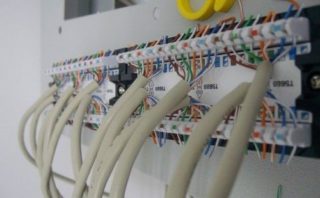
Laying the line from the access point to the PC or switchgear is performed with a single cable without the formation of butt joints. The introduction of the twisted pair cable into the apartment is organized through a hole in the wall adjacent to the common corridor. It is formed with a plastic sleeve cut from a pipe of a suitable diameter.
On the section of the route from the floor panel to the entrance to the apartment, the cable is laid in a box. In the same way, its open wiring is made out inside on the walls of the apartment. In this case, instead of a duct, standard cable ducts or skirting boards of a special design (with voids for laying wires) can be used. They have removable covers, which, after being placed in the niches of the twisted pair, simply snap into place. Then the cable is passed to the place of its connection to the RJ 45 socket.
Features of installation and connection
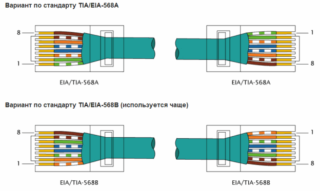
The order of installation of sockets in the selected place is determined by the way the twisted pair cable is laid (it is usually laid open). Therefore, a surface method is used to place them. Before connecting a twisted pair to an outlet, you first have to deal with its disconnection, which means cutting individual cores and preparing them for connection.
The twisted pair is cut according to special schemes, which can be found on any page of the Internet on the relevant topic.
If it is necessary to connect a broken cable or extend it, do not use soldering or twisting. This requires special adapter boxes.

There are several options for crimping the cable (pinouting its ends for connecting to a network jack), indicated by the following diagrams:
- straight 8-conductor cable;
- 8-wire crossover;
- straight 4-conductor cable;
- 4-wire crossover.
Telephone lines can be connected with a straight 4-conductor cable.
Each twisted pair connection to an outlet from this list is suitable for certain situations, depending on the type of devices being connected. According to the schemes given on the Internet, the first type is used to organize a channel between a PC and a router serving a fast Internet line. The third type of wiring for Internet connections is suitable when using a slow data transfer protocol. Crossovers are in demand in special situations when you need to connect two identical ports (two PCs, for example) via LAN outlets.
Connection check and possible errors
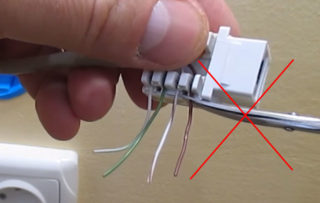
After completing the installation of the power outlet and the installation of the connector at the working end of the cable, it is necessary to check the connection for the reliability of the connections formed. For this, it is most convenient to use a cheap Chinese device that generates test pulses. Its master unit is used instead of a router, and the receiver plugs directly into the outlet. After the impulse signals are sent to the receiver, they are compared. If everything is connected correctly, the green LEDs on the device will light up alternately.
Possible installation errors are divided into three types:
- violation of the protocol (the order of connecting the cores);
- incorrectly selected type of connection;
- damage to the wire during stripping.
Subject to connection requirements, wall outlets will provide a long-term user experience and a reliable high-speed connection.








